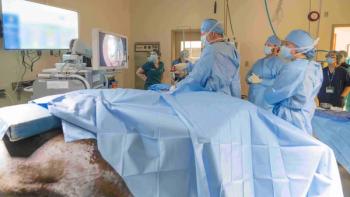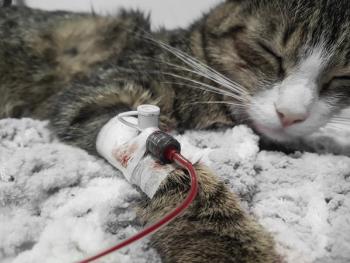
Surgery STAT: Metacarpal and metatarsal fractures: conservative or surgical management?
Metacarpal and metatarsal bone fractures are common injuries seen in the dog, typically resulting from automobile trauma, being stepped upon or having the paw trapped under a rigid object.
EDITOR'S NOTE: SurgerySTAT is a collaborative column between the American College of Veterinary Surgeons (ACVS) and DVM Newsmagazine. Next month, James (Jimi) Cook, DVM, PhD, Dipl. ACVS, writes about the most common surgical procedure performed in veterinary orthopedics, the treatment of cranial cruciate ligament (CCL) deficiency. Dr. Cook currently has a dual appointment at the University of Missouri in Small Animal Orthopaedics and Orthopaedic Surgery (human), and is the Director of the Comparative Orthopaedic Laboratory and the William & Kathryn Allen Distinguished Professor in Orthopaedic Surgery.
Metacarpal (MC) and metatarsal (MT) bone fractures are common injuries seen in the dog, typically resulting from automobile trauma, being stepped upon or having the paw trapped under a rigid object.
Photo 1: Minimally displaced metaÂtarsal fractures in an 8-month-old American Bulldog. Immediate post closed reduction radiographs demonstrating adequate anatomic alignment.
Metacarpal fractures are more common than MT fractures, and fracture of four or more MC bones is more common than fracture of one to three MC bones.
Traditionally, internal fixation (IF) is recommended if two or more MC/MT bones are fractured on a single limb, if the two weight-bearing bones (3 & 4) are fractured and if the patient is a large breed, a show dog or highly athletic.
Photo 2: Comminuted metatarsal fractures in a 5-year-old performance Labrador Retriever. Post-operative radiographs of fluoroscopic-assisted closed placement of intramedullar pins (prior to splinting) demonstrate proper implant positioning.
However, many of these recommendations stem from older human literature and are poorly validated in veterinary medicine. A more recent study compared the outcome of MC and MT fractures managed either with external coaptation alone or in combination with IF. The results revealed little difference between the two in clinical outcome and complication rates. Results also suggested a more rapid rate of healing can be expected with conservative management.
It is the author's experience that closed reduction and coaptation alone often is a very good option for management of 1-4 MC/MT fractures in our small-animal patients.
Conservative management entails closed reduction and coaptation. Ideally the patient is heavily sedated or anesthetized. Allis tissue forceps placed on the nails of digits II and V facilitate traction of the distal limb. The fractures are manually reduced, and a soft, padded bandage applied. A spoon splint on the palmar surface of the limb is incorporated to provide rigid support for MC fractures. A bivalved cast or lateral splint can be used for MT stabilization.
Radiographs are obtained to confirm anatomic alignment of the fractures (Photo 1). While overlap of the bone segments by 50 percent is considered acceptable and will heal, one should strive for anatomic alignment.
Surgical management should be considered in distal and articular MC/MT fractures, if the fractures cannot adequately be aligned with coaptation alone, or in the traditional cases mentioned above.
Breed-specific fractures, such as fracture of the 5th metacarpal bone in the racing Greyhound, also may benefit from IF.
Internal fixation can be challenging in small-breed dogs or skeletally immature animals. Internal fixation improves bone alignment and cortical contact, while providing little in the way of fracture stability. Therefore, external coaptation is still required for six to eight weeks after surgery.
In addition, an open approach can compromise blood flow significantly, which may result in delayed healing, infection and skin necrosis over the implant. If IF is indicated, placing the limb in a compression bandage and delaying surgery 24 to 48 hours will allow for reduction of swelling.
Intramedullary pins driven normograde from the distal segment, through a burr hole just proximal to the articular surface is one useful technique. Pin insertion is preferentially performed under fluoroscopy, avoiding the need for an open approach and minimizing disruption of the vascular supply (Photo 2).
Intramedullary pins are applicable to most patients, although some toy breeds do not have defined medullary canals in the MC/MT bones. Use of lag screw fixation (oblique fractures) or stabilization with a small bone plate (1.5 mm or 2.0 mm) and screws also can be effective.
Recommended follow-up for either conservative or surgical management includes bandage changes every 10 to 14 days to minimize risk of splint/bandage complications and radiographs every four weeks to assess bone healing and ensure a successful outcome.
Peter J. Lotsikas is an ACVS board-certified surgeon with the Veterinary Orthopedic and Sports Medicine Group (VOSM) in Annapolis Junction, Md. Dr. Lotsikas and VOSM specialize in orthopedic injuries of the performance dog. His clinical focus is on minimally invasive surgery and fracture management.
To locate a diplomate, ACVS has an on-line directory, which includes practice setting, species emphasis and research interests (
Newsletter
From exam room tips to practice management insights, get trusted veterinary news delivered straight to your inbox—subscribe to dvm360.




